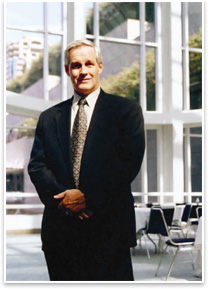
| Jon Magnusson, PE, Hon. AIA
Profession: Structural engineer Educational background: I got my bachelor’s degree in civil engineering from the University of Washington here in Seattle and my master’s degree in civil engineering from the University of California at Berkeley. Even though it’s a master’s in civil engineering, I took 100 percent structural engineering classes. Job description: I serve as a structural engineer on large-scale commercial, institutional, cultural projects, so my clients are architects 95 percent of the time. Childhood ambition: I think it always was related to construction. For some of our family trips, we used to go visit construction sites. I can remember being eight years old and standing at the foundation of what would eventually become the Space Needle. There were these huge anchor bolts that were bigger than me, right in front of me, so I think that from my very earliest memories, it involved construction or design. When I got to college, I didn’t really know whether I wanted to go the construction or design direction, but I really enjoyed a lot of the creative up-front parts: starting with a blank sheet of paper and figuring out where it goes from there. I felt like I got the excitement of construction because you’re still involved in the construction process, but what I liked was being involved up front where you’re really shaping what’s being built. Favorite place: One of my favorite places to visit is Hong Kong. The geographic setting and the mix of the Chinese and British cultures is incredible. It’s just an exciting place. Greatest achievement: My overall greatest achievement is my family, my kids. That’s more important than anything I do at work. Greatest professional achievement: I guess in terms of professional achievement, probably one of the most challenging technical assignments was the Experience Music Project here in Seattle for Frank Gehry. Figuring out how to do a completely free-form building was a big challenge. Most interesting project: I’d say probably the Seattle Library that Rem Koolhaas designed. That was a fascinating project. I think that I was fascinated as much by the thought process and the intellectual aspect of how the design was developed as the design itself: the idea of reinventing the library and absolutely dissecting it to figure out exactly what was going on with the program and how it could best be served. Critical issues in structural engineering: One of the big issues is how to properly deal with terrorism and what the appropriate responses are for our society. There are a lot of code change proposals that are being considered now that may sound good but they really do nothing in terms of public safety. I really think that there are some truth-in-advertising issues that the proponents of these code changes need to deal with, because they don’t deliver what they’re promising. It will have a big impact on the industry, depending on how this all turns out because it not only affects the cost of construction but also what kinds of structures architects can even design. There are design issues—design freedom and design flexibility—involved. If they were truly increasing safety, that’d be great, but if we’re going to have the extra cost and the restrictions on buildings without increasing safety, then we’re just doing the public a big disservice. On performance-based design: The performance-based design approach is so much better because you’re putting the building materials where they can be most effectively utilized in resisting the forces. By designing around the performance that you’re seeking, it’s actually one of the most sustainable and green approaches that you could take, so it’s not just great earthquake resistance, it’s more efficient utilization of our natural resources. Best practice tip: I think that engineers can be most helpful in the creative process if we’re brought in early and not just trying to paint some structure onto a design, but I also think engineers have an obligation if they are brought in early to not get too technoid on the process, keep an open mind to things, and really work hard to understand and achieve the goals. I know engineer after engineer who says, “Bring me in early,” but if they’re not helping the process by coming in early, then they shouldn’t be there. |
||
Copyright 2006 The American Institute of Architects. All rights reserved. Home Page |
||
news headlines
practice
business
design
Photo courtesy of Magnusson Klemencic Associates.
Visit Magnusson Klemencic Associates online.

